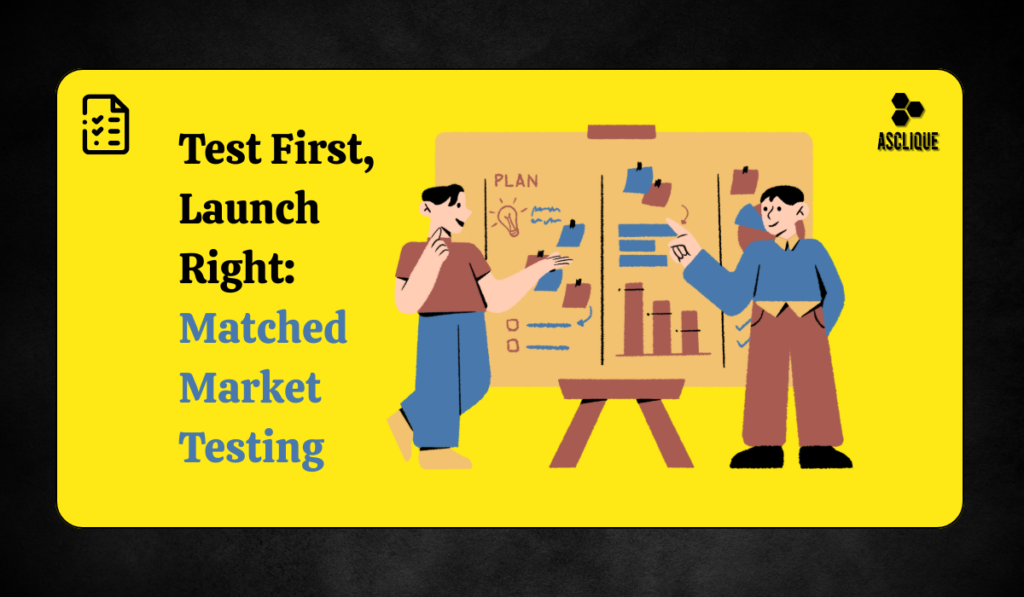In today’s fast-paced world of businesses and digital marketing, launching a product or service seems to be a gamble. The first thing companies can do is show that what they do satisfies the demand and preference of the consumers. One good practice for a company to follow in ensuring that the newly introduced product matches consumer demand is to conduct match market test or market testing. It can enable a business to test the offering in a market very similar to the target audience, thus bringing insights into how the new service or product will take off before the official introduction.
What is Matched Market Testing?
Matched Market Testing refers to the methodology that companies use to run certain products, services, and marketing strategies through a test in a market segment that closely resembles the characteristics of the target audience. This ensures that businesses are getting accurate feedback that is reflective of the behaviors, needs, and preferences of their ideal customers. A match market Test would allow firms to make sounder decisions based on data, further refine their products, and adapt certain marketing strategies according to real-world customer behavior.
Why is Matched Market Testing Important?
Matched market testing is crucial for many reasons. First, it helps reduce the uncertainty of launching a new product. By selecting a test group that mirrors the target market, businesses can gain insights into whether the product will resonate with the intended audience. Additionally, a match market Test ensures that businesses can identify potential issues early in the process, which saves time and resources in the long run.
An important advantage of the matched market test is that it serves to optimize the design, features, and pricing of the product prior to a larger rollout. Feedback from the test market allows for consumer input regarding what they want, what they do not want, and the changes a company must undertake.
Types of Matched Market Testing
There are several approaches to conducting a match market test, each designed to provide different insights depending on the business’s goals. Here are some of the most effective methods:
- The concept testing part of a matched market test often includes evaluating product concepts with consumers who are very similar to the target audience. This helps establish interest in the concept and helps to identify improvement opportunities.
- Prototype Testing After refining the concept, prototype testing can take place. This is the point where a product prototype or minimum viable product introduces the target market. (MVP). The matched market test allows to get the feedback on functionality, design and appeal from the matched market.
- Pilot Testing A company releases its product to a limited region or a small group of customers who are a duplicate set of customers who would be looking at the product to conduct a pilot test, which is a comprehensive matched market test. The matched market test will allow them to find out how the product sells in the real world and make changes as necessary before larger expansion.
- A/B Testing A/B testing is a test of two versions of a product or marketing campaign to see which is more effective. Matched market testing is used to ensure the A/B test audience is representative of the target market the test is intended for.
- Customer Segmentation Testing Sometimes, companies might also want to test the performance of their products among different customer segments. A matched market test allows the company to see how different groups in the target audience react to or spend for different features, prices, or marketing methods.
How to Conduct an Effective Matched Market Test
For matched market testing to be successful, it’s important to follow a structured approach. Here are the key steps to conducting an effective match market test:
Establish Target Audiences
The first step in conducting a matched market test is defining the target audience. This includes identifying customers’ demographics, behavior, and preferences who are most likely to buy the product. The test audience should resemble this target audience closely; otherwise, the feedback may not be relevant.
Create a Testable Product/Concept
After identifying the target audience, the business should produce a prototype, MVP, or concept representing the final product. Consumers should be able to provide relevant feedback during the matched market test.
Choosing the Testing Method
The business should choose the testing methodology that seems most suitable depending on the product and testing objectives. Be it any testing the only important aspect is ensuring that the test market closely resembles the target audience. That’s the essence of a matched market test.
Data Collection and Analysis
The company needs to accumulate as much insight as possible during the matched market test. Surveys, interviews, and analytics tools are useful for gaining insight into how the product performs. Once the team collects the data, they need to analyze it for trends and any possible improvements.
Using Feedback to Improve
The companies may use the feedback from the matched market test to work on the improvement of the product & service. The improvement could be in terms of features, design, price, or message. The focus here is to see that the product has aligned with the customer’s liking before any full launch.
Getting Ready for Full Launch
The team can advance the matched market test form and make any changes needed for a full launch. All insights collected during the test give a good grounding for scaling the product and marketing to the wider audience.
Also Read: Mastering Looker Studio: Free Features, Pricing, and How to Use It for Digital Marketing
Conclusion
Indeed, matched market testing is an important way of reducing uncertainty in the design and or offer of products. The market test simulates the actual target audience, so businesses can benefit from valuable insights that are immediately actionable in their products or marketing strategies. Whether it would be to develop new insights via concept testing, testing prototypes, or A/B testing, a matched market test ensures that businesses have the edge over their competition even before launching their products.
Matched market testing today is perhaps one of the smartest moves for any company hoping for great results-product match in target customers. Real-world feedback before the full rollout or full-scale launch can give businesses a head start on what decisions are more likely to lead toward success rather than costly mistakes.
FAQs
What is matched market testing?
It’s testing a product or service in a market that mirrors the target audience for accurate feedback.
Why is matched market testing so important?
It helps reduce risks by ensuring the product meets customer needs before launch.
How long does matched market testing take?
Length can vary, but it usually tends to roll few weeks to a couple of months depending on the tests-clearness scope and complexity.
What kind of testing is done in matched market tests?
Common ones include concept testing, prototype testing, pilot testing, A/B testing, and customer segmentation testing.
Can any product use matched market testing?
Yes.In principle, companies can conduct matched market testing on any product/service, particularly those that target a certain customer segment.

